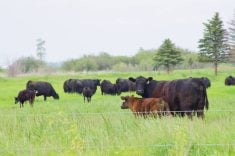Cultures in which it is customary to eat pretty much everything but the moo from meat animals must be scratching their heads over North America’s squeamishness over so-called “pink slime” beef.
Lean finely textured beef, as the industry calls it, has never been sold in Canada. Health Canada considers the ammonia treatment the product undergoes to kill off bacteria a food additive, which must be approved. No one has yet applied for that approval. Given the debacle in the U.S., that’s not likely to happen anytime soon.
Read Also

Your best (and easiest) holiday dainty tray
Make-ahead recipes, store-bought goodies and co-operation with friends and family: Here’s how to throw together a stunning, low-stress tray.
It’s pretty hard to find the product in the U.S. either after most of the plants manufacturing it closed last month, throwing hundreds of people out of work.
It’s hard to say exactly where things started to go so terribly wrong, but it’s clear the product’s makers and ultimately the whole beef industry was caught flat footed when the frenzy began. Then it developed a case of “foot in mouth” as things unravelled.
They could be forgiven for that. After all, the product, which uses a centrifuge to separate the remaining bits of meat from the fat after the main cuts are removed from the carcass and treats it with ammonia to kill bacteria, had been in the food supply for two decades and was used in 70 per cent of ground beef products.
But BPI Inc., the largest manufacturer of the beef product, refused to comment for two weeks after the story broke in the mainstream media. This was already after it had gone viral in social media.
Two weeks is a long time in the PR business. Then, the company was defensive, essentially saying there was nothing wrong with its products and if people stopped buying it, it was going to close plants and put people out of work. The meat industry’s initial response was, “Well, it’s cheap, it won’t kill you and we’re busy feeding the world,” backed up with dry, academic statements about how the process is carried out.
You could argue that anyone who is willing to eat chicken nuggets, hotdogs or pastrami shouldn’t have a problem with lean finely textured ground beef. In fact, as Temple Grandin pointed out to a Brandon audience last week, pink slime is a sustainable product because it reduces waste in the order of 15 to 30 pounds per carcass. This alone should make it a winner in right-thinking households.
It should be noted however, that while much of the public’s shock and dismay was over the fact that it even existed, the underlying story, and the issue that needed airing, questioned the safety of efforts to reduce its unappetizing ammonia smell by cutting back on the bacteria-killing ammonia. There was some evidence to suggest it wasn’t.
In her customary matter-of-fact way, Grandin offered some wholesome advice on pink slime and other issues to livestock producers during her presentation to the packed house in Brandon.
If you wait for other people or organizations to tell your story, you might not like how you are portrayed. Livestock producers need to tell their own story — their normal, everyday life-of-the-farm kind of story, using new media such as YouTube, Grandin said.
But there’s a catch: they also need to tell the truth. And the truth in the livestock and meat business isn’t always pretty.
She argues the industry could have quickly doused the pink slime flames with its own YouTube videos demonstrating the product is not made from floor scraps and by highlighting how it fits into leaner and greener agendas.
But now it’s off the shelves, quite possibly for good. All that can be done now is learn from the experience. And if the Canadian agricultural sector’s response recently to an issue that easily could have spiralled into a major kerfuffle is any indication, it has been doing just that.
Livestock groups and the Canadian Federation of Agriculture were quick to respond to critics of new federal measures that allow producers — under special circumstances and a veterinarian’s supervision — to slaughter meat animals before they are transported to the abattoir. The provisions are mainly there to allow producers to salvage the meat from livestock that is injured so that it cannot be safely or humanely transported.
Some, including a few who should know better, jumped on the provisions as raising food safety concerns, even suggesting that it would result in roadkill being delivered into the food chain.
The response from producer organizations was immediate and matter of fact, emphasizing the meat would still undergo full inspection and highlighting both the human safety and animal welfare benefits of this allowance. Any reasonable person would conclude that scandal had no where to go.
It sure beats getting slimed.















